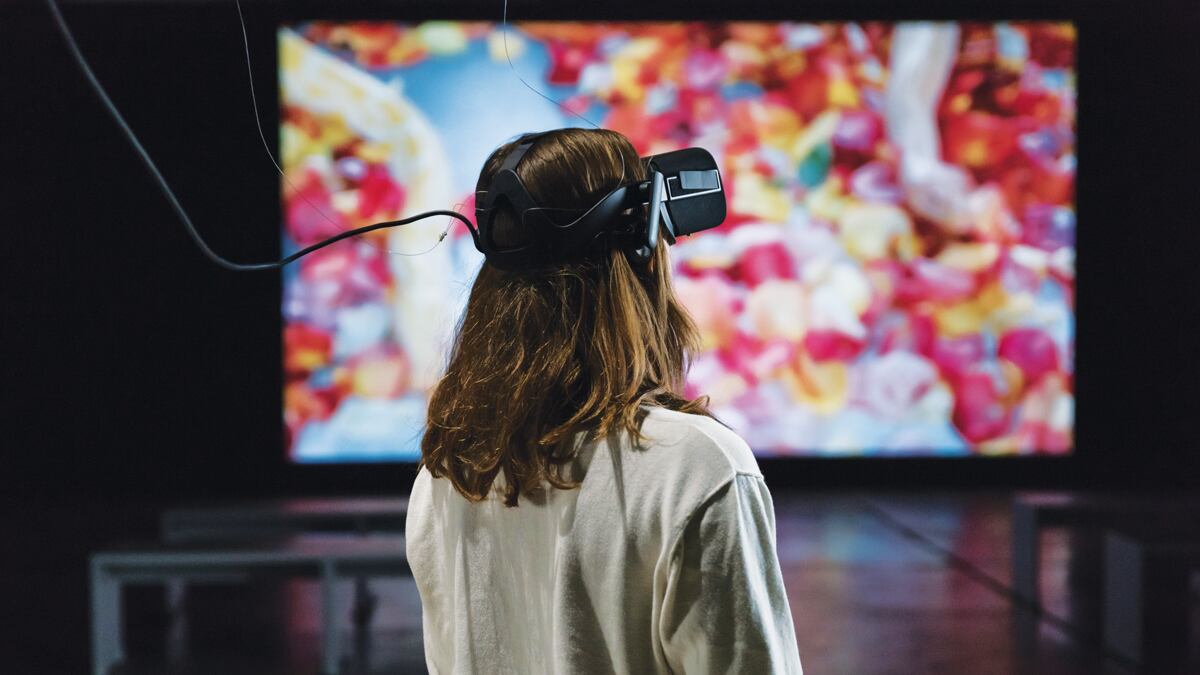To create her exhibit Cloud of Petals, New York artist Sarah Meyohas assembled 10,000 roses and a team of 16 men. Over several days in 2016, those men sat at desks in the central atrium of Bell Works Labs in New Jersey. They pulled apart each rose, selected the petal that they deemed the most beautiful, then photographed that petal. The 10,000 photographs were analyzed by a self-learning algorithm that use the data to generate digital rose petals.
The tedious process resulted in something that's effortlessly sublime—VR programs that place you in a black void, surrounded by the digitally generated petals. They're on display in Disjecta's Kenton gallery, along with a video that abstractly depicts the data collection process. There are wide shots of the men silently sorting the rose petals, of Meyohas trying to balance dead flies on electrical cords and of plump, yellow pythons slithering through petals on the atrium floor.
Cloud of Petals premiered earlier this year at a gallery in Manhattan. There were large photographs, sculptural pods lined with mirrors and electrical wires, a mosaic of petals displayed behind glass and two more VR programs.
The Portland iteration, which opened the week the Manhattan show closed, is much smaller than its predecessor. But it hardly feels like a downgrade. Without the photography and sculpture, Cloud of Petals almost seems more radical—it's reduced to video and VR created by a self-learning algorithm. For the exhibit, Disjecta's white walls have been painted black, and the space is dimly lit by the glow of the video and a small spotlight over each headset. Turning the gallery into a dark, cavernous space seems crucial to making the Portland iteration feel like not just an abridged version, but something more intimate. In the dark room, the works are like tunnels out of a void.
If nothing else, the VR programs are worthwhile purely for their aesthetic value. They place you in a black vacuum full of petals that float above your head and down below your feet. In one program, there's a carpet of petals that fly up into the air when you look at them, as if they've been disturbed by a leaf blower. In another, the petals float around the space in a violent swarm that looks like bees around a hive.
But as an appendage of the video, they're also deeply intriguing. At first, the video seems like some kind of Gestalt joke about attempting to dissect and quantify beauty. It's slightly absurd watching bouquets slowly and meticulously reduced to individual petals placed on numbered pieces of card stock, arranged in a grid on trays and then slotted into tall metal shelves.
Still, it doesn't feel like Cloud of Petals hopes to use its scientific impulses to make any specific discovery. Like exponential decay, it examines each rose on a smaller and smaller level without ever getting closer to discovering where its beauty runs out. There's a shot of a digital petal on a computer screen that zooms in so much, it becomes a grid of red hues.
The video starts the same way it ends—a digital rose petal reduced to the primary colors of light pulsing in each tiny pixel on a giant screen. All those rose petals and all those hours of pulling them apart can be reduced to just red, green and blue. On the other hand, those three colors can build 10,000 intricate, unique petals. In that way, a self-learning algorithm and VR programs feel like a totally natural art medium, more suited to illustrating infinity than pinning it down.
SEE IT: Cloud of Petals is at Disjecta Contemporary Arts Center, 8371 N Interstate Ave., disjecta.org. Noon-5 pm Friday-Sunday, through Jan. 13.

